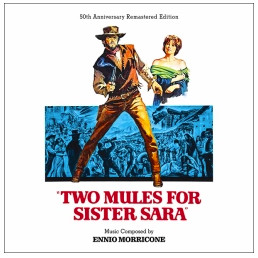TWO MULES FOR SISTER SARA (1970)
Two Mules for Sister Sara is an American spaghetti western directed by Don Siegel, starring Clint Eastwood in one of his most popular early leading roles following his success in Sergio Leone’s Dollars trilogy. The film is set in Mexico just after the American Civil War, and sees Eastwood playing Hogan, a former soldier. Hogan rescues a woman from being raped by bandits, and discovers the woman is a nun, Sister Sara (Shirley MacLaine). Sara is raising money to assist Mexican revolutionaries fighting against French occupying forces, and she convinces Hogan to take her to the Mexican camp; the mismatched pair sets off across the desert, and must overcome various threats and obstacles to reach their goal.
Two Mules for Sister Sara was one of the first films where Morricone worked with an American director within the recognized Hollywood studio system, and as such can be considered something of a landmark score. Thankfully, these new surroundings didn’t dampen Morricone’s creativity at all; the score is very much rooted in the now-established spaghetti western sound he created for Sergio Leone, Sergio Corbucci, and others, and is just as quirky and idiosyncratic as one would expect. The “Main Title” introduces the two main themes; the first is a broad, adventurous theme for guitars, flutes, and the full orchestra, and which features the score’s gimmick – a little instrumental flutter intended to mimic the sound of a mule’s hee-haw; the second is a liturgical choral theme steeped in Catholic religious music that acts as a motif for Sister Sara herself.
The main Adventure theme appears regularly throughout the score; “The Braying Mule” offers an even more peculiar arrangement that adds marimbas and creaking percussion to the mix, while “The Cool Mule” allows the flute performances to become even more flamboyant and impressionistic, often sounding wildly improvised.
There are also several lovely returns to Sister Sara’s theme. In “A Time for Miracles” the choral theme is re-orchestrated for a different instrumental ensemble, and includes a very gorgeous interlude for lilting guitars. “Night on the Desert” offer a slightly distant, wistful take on the theme, wherein the melody jumps around from florid Spanish guitars to fluttering piccolos, and a variation of the theme that uses warm and romantic woodwinds rather than vocals. The main concert statement of the melody is “Sister Sara’s Theme,” which again uses inviting acoustic guitars and elegant woodwinds as dominant textures.
The rest of the score is dominated by Morricone’s idiosyncratic action and suspense music to underscore the various dangerous encounters Hogan and Sara face on their journey. “The Swinging Rope” and “La Cueva” favor tight string phrases, shrill woodwinds, tension-filled guitars, nervous rattling percussion and strummed banjos. “The Battle” is the score’s major action set piece, a fantastic and vivid eruption of bold horns, swirling strings, and martial percussion that leads into a reprise of the “Main Title” to close.
The album, released by La-La Land Records in 2020, offers two versions of the score as part of a 2-CD set: the first is a straight re-issue of the original 1970 vinyl LP release of the score, the second is a re-mastered expansion of the score in chronological order, containing several previously unreleased cues that increase the running time by more than half an hour. Two Mules for Sister Sara is clearly not one of Morricone’s better western scores, but it’s fun nevertheless, and is interesting from a historical point of view.
Track Listing: 1. Main Title (Film Version) (4:17), 2. Dynamite (1:18), 3. Sara’s A Sister (2:48), 4. The French Are Coming (1:40), 5. Hiding in the Ruins (4:04), 6. A Time for Miracles (2:00), 7. Two Mules Theme (3:32), 8. Up That Tree/Colonel Dies (3:09), 9. La Cueva (2:19), 10. Yaqui Go Home (2:22), 11. Trestle (2:32), 12. Hiding in the Ruins Again (4:53), 13. La Cantina (1:36), 14. The Swinging Rope (3:46), 15. Night in Juarista Cave (2:08), 16. Two Mules Theme (Reprise) (2:29), 17. Arrival at the Church (1:08), 18. Sara’s Ruse/Hogan Kisses Sara (3:29), 19. The Battle (3:36), 20. End Title Theme (1:28), 21. Main Title (Original Version) (4:17), 22. Main Title – Original Album Presentation (4:10), 23. A Time for Miracles – Original Album Presentation (1:54), 24. Night on the Desert – Original Album Presentation (3:13), 25. Sister Sara’s Theme – Original Album Presentation (5:18), 26. The Swinging Rope – Original Album Presentation (3:40), 27. The Braying Mule – Original Album Presentation (2:30), 28. La Cueva – Original Album Presentation (2:13), 29. La Cantina – Original Album Presentation (1:32), 30. The Cool Mule – Original Album Presentation (2:16), 31. The Battle – Original Album Presentation (3:30), 32. Main Title (Reprise) – Original Album Presentation (3:26). La-La Land Records LLLCD-1525, 93 minutes 21 seconds.












